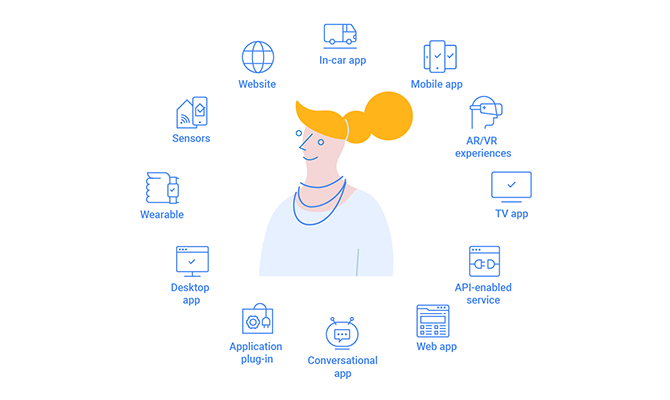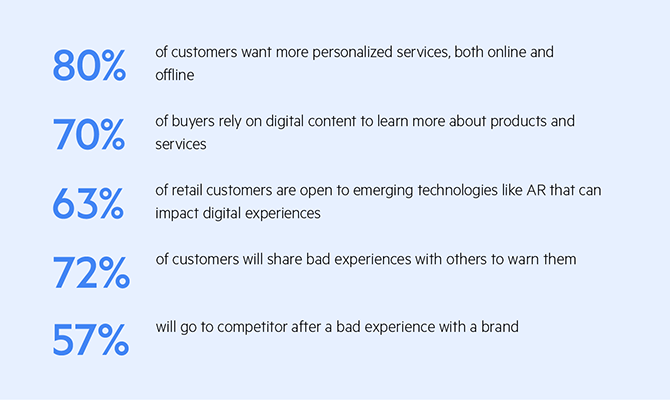How are New Expectations Affecting Personalization in 2020

It is the best of times and it is the worst of times for marketers and personalization. Losing leads and customers has never been easier. In this blog post, we will look at how personalization is affected by today's expectations, backed by figures and facts.
It began the usual way, with a forsaken email with my name on top, and a message below that hoped to find me well and urging me to buy. And to buy now. Here it was, a feeble attempt at personalization, in the wake of the second decade of the second millennium, where 80% of consumers say they will choose and spend more on brands that offer a great personalized experience.
Even though businesses across industries are recognizing that personalization and customer experience are critical components of success, and despite the wealth of analytics and data available to marketers, such cases are no exception. Time and again, marketers stick to the old ways of randomly tossing assets at arbitrary people with the hope that something will stick, instead of knowing their customers deeply and connecting with them continually.
Naturally, most marketing leaders aim at having one-to-one personalized conversations with their customers, however they fall short and fail in spite of efforts. According to a Gartner survey, brands risk losing 38% of customers because of poor marketing personalization efforts. Even as far back as 2017, Accenture estimated that personalization failures cost US firms $765 billion on an annual basis.
Missed opportunities do not just equate to lost profit gains in dull numbers. When it comes to expanding and retaining your customer base and meeting the ever-rising customer expectations on experience, there certainly is nothing more important than personalization, done the right way. The behavior of consumers across the board reveals that they do not just expect personalization—they demand it.
Marketers can no longer afford to view personalization as a one-time effort or, say, as email segmentation and product recommendations. They need to utilize personalized marketing as a strategic requirement if they are to increase engagement, enhance loyalty, convert prospects and build revenue. And do so as a long-term plan.
74% of executives say that less than 10% of their marketing budget is dedicated to personalization. — Forbes
What is Personalization?
Personalization is a marketing strategy of tuning out the noise and connecting with customers and prospects to make them feel their needs and priorities are met with a tailored touch, that they matter and are heard and understood, and that they hold a personal conversation/connection with the brand, thus building a trusted relationship. This takes time and cultivation.
The best way to understand what this personal touch means is to look at companies that are doing this pretty successfully. Examples that immediately jump to mind are Spotify and Netflix, whereby technology is leveraged to provide unique experiences to visitors and treats them and makes them feel like individuals, rather than specks in the crowd. No two Netflix or Spotify home pages are the same.
Be it catering to users’ needs before users themselves even know they want to watch that show, serving experiences based on their preferences, or surprising and delighting them with a new playlist—it all boils down to treating every user as an individual and solving their specific problem, answering their need, or providing quality service even though the customer base may be growing at an exponential rate.
Thus, while every brand has a story to tell, breaking through the noise and being heard in today’s content-heavy digital ecosystem is only possible by building connections and relationships with prospects and customers around any of their needs and wants via tailored and meaningful experiences. Executed properly and supported by the right platform in place, personalization in marketing initiatives strengthens brand loyalty, customer engagement and retention, and a multitude of other key performance indicators.
Companies that have managed to mature in terms of marketing capabilities and personalization initiatives are gaining competitive advantage for the long-run, while delivering value in a matter of months. So, if personalization is so critically in demand, why are so many companies still struggling to get it right?
Deliver Compelling Digital Experiences
While the definition of personalization has not changed much in the past decade, the ways consumers interact with brands in the modern digital era have never been more diverse. Delivering a compelling, personalized customer journey across multiple digital touchpoints has never been more important, yet—never so complex. Many organizations struggle to personalize their campaigns and build cohesive multichannel experiences, thus missing out on improving customer satisfaction and increasing the probability of repeat visits.
"Consumers are redefining brand value on their terms, demanding greater convenience and relevance from every engagement and every device." — Gartner Top 5 Marketing Predictions for 2018
A survey by Progress of 900+ decision-makers identified the digital experience wants and needs of app developers, web developers and business leaders worldwide and that digital should be every organization’s competitive advantage. It’s clear from the survey results that delivering compelling digital experiences is front and center for digital leaders in order to deliver business results and stay competitive.
"Providing consumer-grade digital experiences is not optional—it's a must to stay competitive." — Yogesh Gupta, CEO, Progress
Going a step further, hyper-personalization is a deeper level of personalization that few companies ever venture into. Hyper-personalization is extremely persuasive in getting customers to convert since marketers combine all touchpoints across web, mobile, email, advertisements, offline, and so on in building and sustaining a comprehensive and continuous journey. This combination of touchpoints is becoming critical for better engagement and individual conversions and is the core of hyper-personalization.
Hyper-personalization requires a company to have a profound understanding of its own products or services and an all-encompassing view of the customer or prospect, so that it creates truly bespoke experiences. A key component of such experiences is to build a “living” marketing tactic that manages to convey exactly the right message, experience or offer to customers in exactly the right context, that is, stage of the customer journey. Consequently, a robust personalization strategy involves personalized and tailored content for each phase of the journey, based on past and current behavior, persona, contextual inputs, and, when possible—anticipated individual needs.
Hyper-personalization is tightly connected to the experiences customers demand or else they will just go to your competitors. Experiences a company provides are as important as its products and services and raise consumers’ expectations of other companies, especially having in mind that 54% of customers say companies need to transform how they engage with them.
Expectations and Experiences—Going Omnichannel
As we are consumers ourselves in a world obsessed with big data, ML and AI-driven algorithms, and singular attention, it is only natural that we deliver the same to our customers and prospects who also expect experiences tailored to their specific needs, values, and behavior. Moreover, as the scope of personalization expands proportionally across the customer journey, organizations are required to respond with tailored omnichannel experiences at scale, at each touchpoint, whenever and wherever consumers want to interact. This includes website content, mobile apps, social media, email, IoT devices, wearables, digital signage, and so on.
While the concept of omnichannel is not new, the scope has vastly expanded. In recent years, the market has seen the introduction of tons of different interfaces—smartwatches, virtual reality headsets, specialty interfaces, product displays of different sizes, augmented reality viewports and more. However, the reality is that while customers are no longer confined to a select number of screens, many businesses lack the ability to create truly omnichannel experiences that incorporate all these new ways that customers are interacting and interfacing with content.
In fact, many still struggle to even deliver across web and mobile. And even if enterprises do have omnichannel experiences, they often still have issues supporting cohesive digital experiences spanning multiple touchpoints with any sort of speed or agility.
You’re not behind your competitors; you’re behind your customers—behind their expectations. —Brendan Witcher, VP, Principal Analyst at Forrester
Today, consumers’ expectations have radically shifted towards a fluid omnichannel experience that transcends media and allows them to switch seamlessly between touchpoints how they want to and when they want to. Your goal, then, as a business, is to keep customers within the brand ecosystem, with each channel and touchpoint working in accord to nurture more engagement and sales.
Your goal as a marketer is to provide the personalized experiences that communicate the value of your brand and help it stand out among the competition. You can do this by understanding consumer behavior and adapting to how it has changed, thanks to the knowledge gained by technology and interactions history and predictions.
Connected customers have grown accustomed to a digital landscape that is always accessible from a variety of existing and emerging touchpoints, from desktop computers to smartwatches.
 A personalized experience therefore is a seamless experience. This means the customer feels the same level of attention from you on your website or mobile app, your social media channels, your conversational interfaces, your technical support line, and so on. And as much as customers demand a personalized service, attention, and conversations, they now expect to be able to control it. In this new reality, customers buy and pay more for experiences, not just products.
A personalized experience therefore is a seamless experience. This means the customer feels the same level of attention from you on your website or mobile app, your social media channels, your conversational interfaces, your technical support line, and so on. And as much as customers demand a personalized service, attention, and conversations, they now expect to be able to control it. In this new reality, customers buy and pay more for experiences, not just products.

A Progress study into the new expectations and demands that business are facing concludes that there are still a wide range of companies guilty of not meeting expectations of their constituents, who expect better digital experiences than are currently delivered. To make matters worse, companies that do not meet expectations are being harshly punished for it—users are not forgiving for subpar experiences, so if businesses cannot deliver, they risk losing their users.
If personalization and customer experience are the goals, every customer touchpoint must align with the company’s core understanding of the customer and adapt to how the customer wants to be engaged. Even though the goal is personalization and relationship-building, not sheer bottom line numbers that may change in a whiff, the outcome is a positive and a definite contribution to the business results.
Organizations able to skillfully manage the entire experience reap enormous rewards: enhanced customer satisfaction, reduced churn, increased revenue, and greater employee satisfaction. —Harvard Business Review
Engagement and Loyalty
Traditional marketing belief advocates that good personalization practices inevitably result in a boost in customer engagement. HubSpot defines it as "the ongoing interactions between company and customer, offered by the company, chosen by the customer.
It should be clear by now that consumers and buyers today are the ones setting the agenda of how and when they interact with brands and are in charge of their own journey and therefore—engagement with brands. They are looking for relevant points of always-on connection in a world where everything and everybody is connected.
The demanded experience is now a differentiator and the service is what makes them come back, regardless of the price of the product and the size of the brand. Thus, engagement does not automatically equate to brand loyalty as it used to since consumers are constantly reconsidering their purchasing decisions, researching for a better deal, or reevaluating the experience.
Engagement nowadays represents and signifies the personal relationship that offers consumers value wherever they are and whenever they are willing to engage—this, ultimately, is the experience, not the brand behind it. In turn, value entails a profound degree of convenience, relevance, speed, and top-notch timing that will drive repeated visits, purchases, and engagement.
These essentially equate to “loyalty” in times when it matters more than ever and in a revised connotation—and marketers need to adjust to this new reality. They need to swiftly remodel their strategies, activities, and initiatives to stay relevant and engage prospects and customers. A vital foundation of this strategy to keep up with today's standards and differentiate from competitors is personalization.
77% of consumers say that convenience is a major factor in selecting their service providers. Furthermore, 68% of consumers globally feel more loyalty toward the brands and organizations that make it easy and convenient to engage with them. —Forbes Insight study
Make Digital Your Competitive Advantage with Sitefinity
Sitefinity is the digital platform that best equips you to face and solve the challenges of delivering personalized, omnichannel experiences to your customers—wherever they are, whenever they engage:
- Compelling, meaningful, personalized digital content is your currency but you don’t buy customer loyalty, you earn and nurture it
- Customer profiling and behavior analytics to continuously improve experiences and engage with a personal touch
- Personalization is an ongoing effort, a full-circle, constantly raising of the bar: evolving customer expectations call for personalized experiences, which in turn raise customer expectations even higher. Don't spiral down—scale up and across touchpoints.
- Exceed—not manage—expectations
- Individual, personalized journeys, no mass messages
- Meaningful engagement at the right time, the right channel with a personal touch that positively affect loyalty and the bottom line.
How do you make personalization work in your organization? Make it count and deliver seamless, personalized experiences across the business. Learn how with Sitefinity Insight.
In the next post in this series, we'll look into what you need to know to build a personalization strategy that works. Keep reading to find out more: How to Plan a Successful Personalization Strategy: The Essentials.

Petra Lazarova
Petra Lazarova was part of the Sitefinity Product Marketing team.
